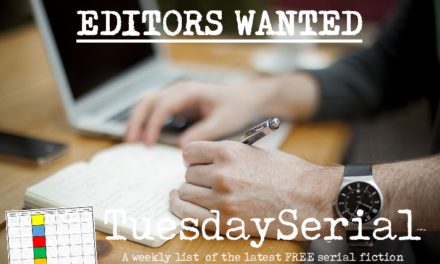We’ve been very focused on the publishing process recently here at Tuesday Serial and this week we’d like to shift gears. If you don’t know KM Weiland, then allow me to introduce her. She is a lovely writer and is the genius behind the writer’s website “Word Play” which features her posts, podcasts and videos on writing craft. I have been reading Weiland’s book “Outlining Your Novel” and when I got to the section about organizing your outline into scenes and determining scene breaks, I knew that I had to invite her to Tuesday Serial to share her wisdom with us. So, welcome, KM! ~PJ
“Eleven Cliffhangers for Your Serial Fiction” by KM Weiland
Scene breaks are important no matter what type of story you’re writing. But this is perhaps even more true of serial fiction. Unlike a novelist, you don’t just have to hook readers into turning the page (as if that’s not tough enough sometimes). No, you—O brave and fearless serial writer!—have to hook them into not just returning next week or next month to read the next section, but remembering to return.
 Below, you’ll find eleven options for ending your scene breaks in a way that will pique your readers’ curiosity and drag them back to read your next installment.
Below, you’ll find eleven options for ending your scene breaks in a way that will pique your readers’ curiosity and drag them back to read your next installment.
Excerpted from Outlining Your Novel: Map Your Way to Success
Scene breaks are do-or-die territory for novelists. You may be spinning a grand ol’ tale, full of fascinating characters, but if your chapter and scene endings leave readers no reason to turn the page and find out what happens next, all your hard work on the other aspects of your story will be wasted. Not every scene needs to end with a cliffhanger, but they do need to encompass a question powerful enough to make the reader crazy to know the answer.
This is no easy task, in large part because not every scene is going to feature huge revelations and startling questions. How do you mine your story for the tension and conflict that will translate into the most powerful question a reader can ask: What’s gonna happen next? Following are eleven suggestions for turning your blasé endings into killer chapter breaks:
1. Promise of conflict.
Example: The hero has just been challenged to a duel.
Inherent Question: Will he survive?
2. A secret kept.
Example: The hero’s partner hides a letter.
Inherent Question: What’s in the confounded letter?
3. A major decision or vow.
Example: The hero swears to avenge his wife’s murder.
Inherent Question: How will he go about it? Will he succeed?
4. An announcement of a shocking event.
Example: The hero’s father dies.
Inherent Question: How did he die? How is the hero going to react?
5. A moment of high emotion.
Example: The hero is enraged by the promotion of an incompetent coworker.
Inherent Question: How will the hero express his anger? Will he experience repercussions?
6. A reversal or surprise that turns the story upside down.
Example: The heroine discovers her long-dead mother isn’t dead at all.
Inherent Question: Where has the mother been all this time? How is the heroine going to adjust to this new paradigm?
7. A new idea.
Example: The hero comes up with a new scheme for defeating the bad guy.
Inherent Question: Will it work?
8. An unanswered question.
Example: “You’re not who you said you were, are you?”
Inherent Question: Is he who he said he was? If not, who is he? And why did he lie about his identity?
9. A mysterious line of dialogue.
Example: “You’ll find your answers on the Northside Bridge, midnight. Come alone.”
Inherent Question: What are the answers? Why the North-side Bridge? Why midnight? Why alone?
10. A portentous metaphor.
Example: A solar eclipse over a battlefield.
Inherent Question: Is this an indication of tragedy to come?
11. A turning point.
Example: The heroine is shipped off to an orphanage.
Inherent Question: What will happen in her new life? How will she adapt?
Use a wide variety of breaks to keep your readers guessing. It’s possible—and even preferable—to use all of these examples in one story. Serial fiction works best when each episode leaves readers with a question – a reason to find out more. This is the way to hook readers on your story and keep them coming back for more.
 K.M. Weiland is the author of the historical western A Man Called Outlaw and the medieval epic Behold the Dawn. She enjoys mentoring other authors through her writing tips, her book Outlining Your Novel: Map Your Way to Success, and her instructional CD Conquering Writer’s Block and Summoning Inspiration.
K.M. Weiland is the author of the historical western A Man Called Outlaw and the medieval epic Behold the Dawn. She enjoys mentoring other authors through her writing tips, her book Outlining Your Novel: Map Your Way to Success, and her instructional CD Conquering Writer’s Block and Summoning Inspiration.



Thanks so much for having me today, guys!
It's our pleasure, KM – this is a very informative post 🙂
I LOVE posts like this! So practical; thank you!